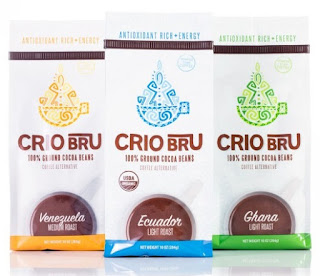That's why I became really interested in a new product I stumbled across at the Fancy Food Show in January. Crio Bru is ground cacao beans that you brew like coffee. Thankfully, they sent me a few bags to try and I am happy to recommend them.
Cacao has been a part of the human diet for those in Central and South America and Mexico for 5,000 years. Ancient cultures used to ferment the fruit of the cacao pod to make an alcoholic beverage. The cacao beans were considered valuable and were used for currency. A Spanish soldier who was part of the conquest of Mexico tells that Moctezuma II drank a chocolate drink mixed with spices. If so, I would imagine that the beans would have crushed and boiled, therefore creating a brew similar to what you would get from this Crio Bru product.
Much like coffee, Crio Bru roasts different varieties of cacao beans, crushes them up, and then bags them. The varieties are distinguished by their country of origin and roasting methods, just like coffee or fine quality chocolate. For instance, currently I'm drinking cacao from Ghana that is French (dark) Roasted.
I've been adding stevia and coconut creamer to my brew, much like a coffee drinker would add cream and sugar. This makes a beverage akin to a very thin hot chocolate - without the calories. According to the bag, an 8 oz cup of it only has 10 calories and no sugars. My coconut creamer is 35 calories. 45 calories versus 194 or more? I'll take that!
Crio Bru is touting health benefits as well, especially versus caffeine in coffee. Let's start with some information about caffeine.
The half-life of caffeine (time taken for the body to eliminate one-half of the caffeine) varies widely between people, depending on factors such as age and body weight. The half-life for caffeine in an adult can range from about 3-7 hours. That means if you drink a cup of coffee with, say, 300 mg of caffeine at noon, by 6 p.m. you will still have 150 mg in your system, then at midnight 75 mg, and 6 a.m. 32.5 mg. That's why it takes a good 24 hours for caffeine to completely leave your system.
Some people, myself included, are extremely sensitive to caffeine and can suffer caffeine withdrawals. If I go without caffeine for over 24 hours since my last dose, I get a massive headache. I've actually had caffeine headaches rival and sometimes surpass my migraine headaches.
Cacao has minimal caffeine in comparison to coffee. Compare 5-10 mg a cup to 300 mg in coffee. Instead, cacao has theobromine.
Theobromine is a chemical compound also found in tea and the kola nut. Theobromine has similar compounds as caffeine, with one less methyl group. While humans can digest theobromine quickly, pets can't metabolize it fast enough, thus the warning that chocolate can make your pets really sick or even kill them. That's not to say that adults can't also suffer from theobromine poisoning if the dosing was severe.
Theobromine is a myocardial stimulant as well as a vasodilator, increasing heartbeat, and also dilating blood vessels, causing reduced blood pressure. As with caffeine, theobromine can cause sleeplessness, tremors, restlessness, and anxiety at high doses. So it is a stimulant, but without the withdrawal problems of caffeine.
Cacao also has a lot of other antioxidants akin to those found in berries, pomegranates, and açai. It's high in minerals like magnesium and zinc. It is abundant in chemicals produced by the body but rarely found in most foods: anadamide, an endorphin or “bliss chemical” produced after exercise; phenylethylamine for increased focus and alertness; serotonin, a primary neurotransmitter that helps build a “stress defense shield”; and tryptophan, an amino acid that enhances relaxation and promotes better sleep.
I've enjoyed Crio Bru so much that not only did I buy a French press, but I also bought a high quality thermos to cart around with me. You can buy it directly from CrioBru.com.

.png)




